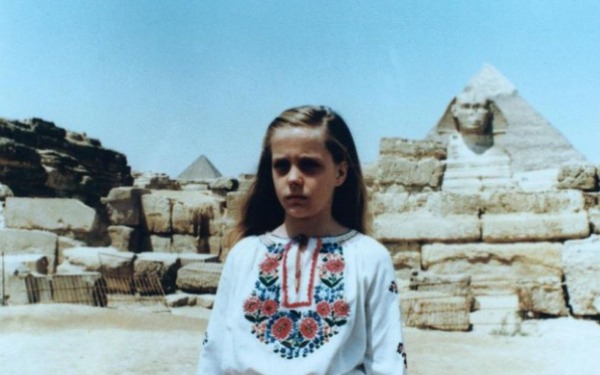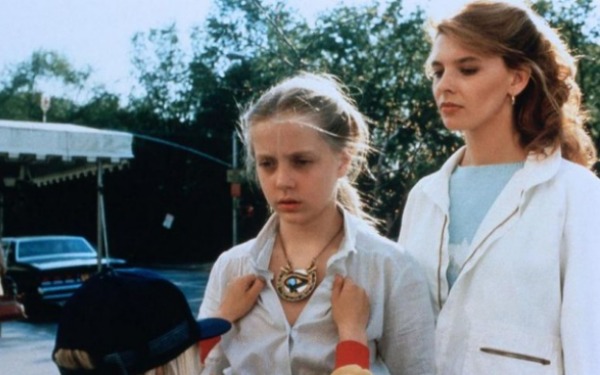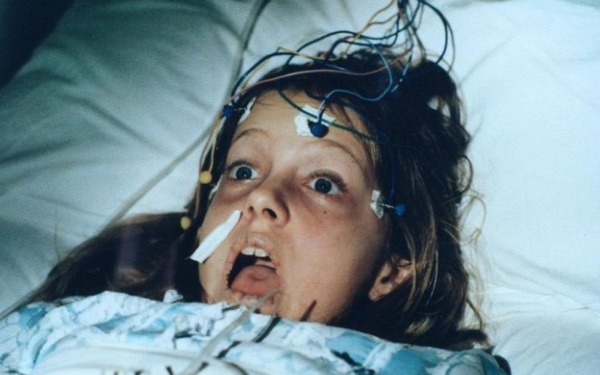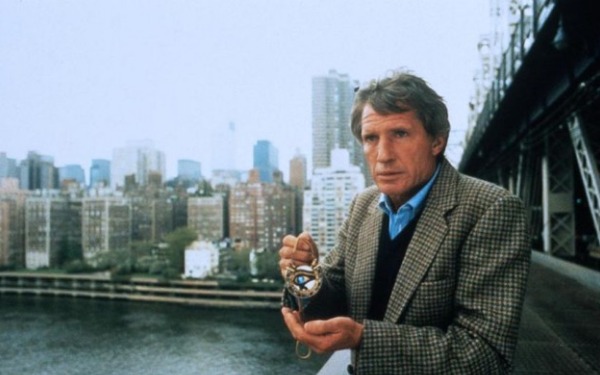- ITALIANO
- ENGLISH VERSION
Scorpioni, monili e note in nero. “Manhattan Baby” (1982), diretto da Lucio Fulci, nasce tra le sabbie dell’Egitto, le cui perdute tombe custodiscono un antico Male, pronto a manifestarsi dall’altro capo dell’oceano, a New York, tramite la possessione di un’ignara bambina. Le musiche sono di Fabio Frizzi, dettano i tempi dell’azione e sottolineano un’atmosfera già carica di tensioni latenti.
 La sceneggiatura di Dardano Sacchetti ed Elisa Livia Briganti non è, forse, delle più memorabili, con una certa flemma nell’incedere del pericolo, ma il risultato finale è da salvare per vari motivi. In primis, la fotografia, di sicuro effetto, perché valorizza l’ambientazione egizia con cromatiche accese e scuote gli spettatori con una serie di primi piani dei protagonisti.
La sceneggiatura di Dardano Sacchetti ed Elisa Livia Briganti non è, forse, delle più memorabili, con una certa flemma nell’incedere del pericolo, ma il risultato finale è da salvare per vari motivi. In primis, la fotografia, di sicuro effetto, perché valorizza l’ambientazione egizia con cromatiche accese e scuote gli spettatori con una serie di primi piani dei protagonisti.
Il professore George Hacker (Christopher Connelly), sua moglie Emily (Martha Taylor), i figli Susie (Brigitta Boccoli) e Tommy (Giovanni Frezza), la tata Jamie Lee (Cinzia De Ponti) e l’occultista Adrian Mercato (Cosimo Cinieri) sono al centro di “Manhattan Baby”. L’archeologo profana la tomba del dio Abdubenor e assiste impotente al manifestarsi del Male da un monile.
L’amuleto, una pietra azzurra incastonata in un’anfesibena d’oro, è il dono di una misteriosa mendicante a sua figlia. La bambina ne sarà poco alla volta posseduta, coinvolgendo anche il fratello e trasformando la sua stanza in una specie di porta dimensionale con l’Egitto dei primi uomini. L’intervento eroico dell’occultista impedisce a Susie di cadere nell’oblio, ma a caro prezzo.
Adrian Mercato, dopo averne assorbito la sua carica negativa, è assalito dai suoi uccelli impagliati che, inspiegabilmente, hanno preso vita. Il finale splatter, citazione de “Gli Uccelli” (1963) di Alfred Hitchcock, lascia spazio anche a un potenziale ripetersi degli eventi, poiché un’altra giovane turista straniera in terra egizia ha ricevuto un identico monile da un’inquietante figura femminile.
Il livello di suspense non è alto come in alcune delle opere del regista romano, ma il suo intuito visionario lo ha indotto a insistere sulla tematica dell’innocenza posseduta, aggirando il precedente illustre de “L’Esorcista” (1973) di William Friedkin. “Manhattan Baby” è maggiormente realistico, perché il Male dilania Susie dall’interno, risparmiandole vistose mutazioni estetiche.
 La bambina è uno strumento nelle mani del dio Abdubenor e i suoi ‘viaggi’ indietro nel tempo divengono il tentativo di trasporre l’orrore in una dimensione ludica. Gli effetti speciali, ad esempio l’uso dei raggi blu, possono apparire discutibili oggi, eppure erano l’ennesimo stratagemma artigianale ordito per migliorare una pellicola a basso budget.
La bambina è uno strumento nelle mani del dio Abdubenor e i suoi ‘viaggi’ indietro nel tempo divengono il tentativo di trasporre l’orrore in una dimensione ludica. Gli effetti speciali, ad esempio l’uso dei raggi blu, possono apparire discutibili oggi, eppure erano l’ennesimo stratagemma artigianale ordito per migliorare una pellicola a basso budget.
La colonna sonora, tanto breve quanto sinistra, fu pubblicata dalla Beat Records Company, in vinile rosso e verde, a ridosso dell’uscita del film nei cinema, ma conteneva anche tracce estratte dalle partiture di “… E Tu Vivrai Nel Terrore! L’Aldilà” (1981), “Quella Villa Accanto Al Cimitero” (1981), “Lo Squartatore Di New York” (1982) e “Una Tomba Aperta… Una Bara Vuota” (1972).
Tracce che riportavano le firme dello stesso Fabio Frizzi, di Walter Rizzati, di Francesco De Masi e di Piero Piccioni. L’operazione compilativa era in parte comprensibile. I nomi dei primi tre compositori erano legati alla parentesi ‘americana’ di Lucio Fulci, ma quello di Piero Piccioni, associato al film di Al Bagran, rappresenta un aggiunta editoriale dettata da motivi di assonanza.
La versione cd della colonna sonora integrale (2011) ha colmato un vuoto di trent’anni; quella della neonata Sub Ost, la costola cinematica della Subsound Records, ha finalmente consegnato agli appassionati il vinile, giallo o nero, di “Manhattan Baby” (2016). Undici tracce prive di titolo, nominate in ordine progressivo, collocabili a metà strada tra krautrock ed elettronica.
Un calibrato mix di suoni comune ai precedenti lavori realizzati da Fabio Frizzi per il regista. Lo score di “Manhattan Baby” rappresenta il penultimo capitolo del sodalizio tra i due, interrottosi con “Un Gatto Nel Cervello” (1990), ma iniziato con lo straordinario “Sette Note In Nero” (1977) e proseguito con l’ultimo western girato da un italiano negli anni Settanta, “Sella D’Argento” (1978).
Un legame inedito durante la lunga carriera di Lucio Fulci, incline ad avvalersi di nuovi e differenti contributi sonori per la sua filmografia dei ‘mondi neri’. È il caso, ad esempio, delle cupe dissonanze di Ennio Morricone in “Una Lucertola Con La Pelle Di Donna” (1971), o delle note sinfoniche di Riz Ortolani in “Non Si Sevizia Un Paperino” (1972) durante il boom del giallo-thriller.
Da un punto di vista non solo anagrafico, Fabio Frizzi appartiene, invece, a una generazione successiva a questi ultimi. Il maestro, spesso in trio con Franco Bixio e Vince Tempera, ha preferito la via delle percussioni, delle tastiere e delle voci sintetizzate. Numerosi, infatti, gli elementi in comune tra le colonne sonore di “Zombi 2” (1979), “Paura Nella Città Dei Morti Viventi” (1980) e successive.
“Manhattan Baby” è parte integrante di questo proficuo filone. Fu registrata nella sala A degli studi Trafalgar a Roma, forse i migliori della Capitale, con Giorgio Agazzi fonico di fiducia e supervisione dell’editore Franco De Gemini, più il contributo di tre formidabili musicisti: Agostino Marangolo alla batteria, Fabio Pignatelli al basso e Maurizio Guarini alle tastiere, ovvero i Goblin.
 I rapporti tra la band e Fabio Frizzi, nelle vesti di giovane compositore o direttore d’orchestra, erano antecedenti a “Manhattan Baby”, basti pensare agli score su licenza Cinevox di “Amore Libero – Free Love” (1974), “La Preda” (1974), a cura di Franco Bixio e Vince Tempera, e “Perché Si Uccidono” (1976), firmato dallo pseudonimo gobliniano Il Reale Impero Britannico.
I rapporti tra la band e Fabio Frizzi, nelle vesti di giovane compositore o direttore d’orchestra, erano antecedenti a “Manhattan Baby”, basti pensare agli score su licenza Cinevox di “Amore Libero – Free Love” (1974), “La Preda” (1974), a cura di Franco Bixio e Vince Tempera, e “Perché Si Uccidono” (1976), firmato dallo pseudonimo gobliniano Il Reale Impero Britannico.
Maurizio Guarini e Agostino Marangolo hanno partecipato, inoltre, a “Paura Nella Città Dei Morti Viventi” e, con Fabio Pignatelli, anche a “… E Tu Vivrai Nel Terrore! L’Aldilà”. Un apporto di classe per caratterizzare al meglio i fotogrammi dello scavo archeologico in Egitto e del terrore domestico. Immagini che necessitavano di temi appropriati, tanto affascinanti quanto evocativi.
E, non a caso, il lato A della ristampa ne è colmo. Baby Sequenza 1, atmosferico, con il suo coro di voci dell’oltretomba, e Baby Sequenza 2, segnato dall’uso del sistro, ne sono due immediate e struggenti dimostrazioni. Nonostante ciò, è la fanciullesca melodia di Baby Sequenza 3, introdotta da un rumore a manovella, a imprimersi con maggiore forza nella mente dell’ascoltatore.
L’armonia di tastiere e basso sembra interrompersi all’improvviso ma, ‘ricaricata’ ancora una volta a manovella, diviene quasi ossessiva per i restanti due minuti. Baby Sequenza 4 riprende, invece, il primo brano, ricorrendo a una struttura melodica priva di percussioni, con inciso di suoni dissonanti del sintetizzatore, bassi più marcati e una serie di campanelli che generano suoni simili a sibili.
Il lato B prende il via con l’arabesca Baby Sequenza 5, utile con i suoi fiati e tamburi a punteggiare le scene girate all’ombra delle piramidi. A Baby Sequenza 6 e Baby Sequenza 8, riprese delle prime due tracce, si contrappongono Baby Sequenza 7 e Baby Sequenza 11, attraversate dalle note di un sassofono in lontananza, un cliché comune in numerose pellicole di registi statunitensi.
 Baby Sequenza 9 e Baby Sequenza 11 provvedono a ulteriori scomposizioni dei temi principali. Nel primo caso, le voci di Baby Sequenza 1 sono meno potenti e, in seguito a ulteriori assoli di sassofono, riparte il giro armonico di tastiera e basso di Baby Sequenza 2. Nel secondo, invece, si mette in evidenza la nenia di Baby Sequenza 3, arricchendola con una breve pausa dissonante.
Baby Sequenza 9 e Baby Sequenza 11 provvedono a ulteriori scomposizioni dei temi principali. Nel primo caso, le voci di Baby Sequenza 1 sono meno potenti e, in seguito a ulteriori assoli di sassofono, riparte il giro armonico di tastiera e basso di Baby Sequenza 2. Nel secondo, invece, si mette in evidenza la nenia di Baby Sequenza 3, arricchendola con una breve pausa dissonante.
La ristampa di “Manhattan Baby” su Sub Ost chiude così un cerchio, rilanciato dal ciclo di prodotti fulciani su Death Waltz Recording Company e, soprattutto, trainato dalle esibizioni del progetto musicale Frizzi 2 Fulci. Da alcuni anni, al termine di una fase di preparazione e riarrangiamento, Fabio Frizzi ripropone dal vivo i temi delle colonne sonore realizzate per il ‘terrorista dei generi’.
Alle spalle di un’orchestra di otto validi elementi, diretta dal maestro, scorrono onirici spezzoni dei film inerenti i brani in scaletta. Dalla partecipazione all’Italian Horror Fest al tutto esaurito alla Union Chapel di Londra, senza dimenticare il tour negli Stati Uniti, i consensi sono stati unilaterali. Il sodalizio Lucio Fulci-Fabio Frizzi continua a vivere vent’anni dopo la scomparsa del regista.
Scorpions, necklaces and notes in black. “Manhattan Baby” (1982), directed by Lucio Fulci, was born among the sands of Egypt, whose lost tombs preserve an ancient Evil, ready to manifest itself at the other ocean cape, in New York, through the possession of am unsuspecting child. Fabio Frizzi‘s music permeates the action and underline atmosphere already loaded with latent tensions.
 The screenplay by Dardano Sacchetti and Elisa Livia Briganti is not, perhaps, the most memorable, with some phlegm gaiting the danger, but the final result is to be saved for various reasons. First, photography, highly effective, because it enhances the Egyptian setting with burning colors and shakes the spectators with a series of protagonists close-ups.
The screenplay by Dardano Sacchetti and Elisa Livia Briganti is not, perhaps, the most memorable, with some phlegm gaiting the danger, but the final result is to be saved for various reasons. First, photography, highly effective, because it enhances the Egyptian setting with burning colors and shakes the spectators with a series of protagonists close-ups.
Professor George Hacker (Christopher Connelly), his wife Emily (Martha Taylor), the children Susie (Brigitta Boccoli) and Tommy (Giovanni Frezza), the nanny Jamie Lee (Cinzia De Ponti) and the occultist Adrian Mercato (Cosimo Cinieri) are the center of “Manhattan Baby” plot. The archaeologist profanes the tomb of the god Abdubenor and stand powerless to the manifestation of evil from a necklace.
The amulet, a blue stone set in a gold amphisbaena, is the gift of a mysterious beggar to her daughter. The child will become gradually possessed, also involving his brother and turning her room into a kind of dimensional door connected to Egypt of the first men. The heroic intervention by the occultist prevents Susie’s fall into oblivion, but at a great cost.
Adrian Mercato, after having absorbed its negative charge, is assailed by his stuffed birds which, inexplicably, have come to life. The final splatter, citation of “The Birds” (1963) by Alfred Hitchcock, also allows for a potential repeat of the events, since another young foreign tourist in Egyptian land has received an identical necklace by a disturbing feminine figure.
The level of suspense is not as high as in some of the works of the Roman director, but his visionary intuition led him to insist on the theme of innocence possessed, bypassing the illustrious precedent of “The Exorcist” (1973) by William Friedkin. “Manhattan Baby” is more realistic, because Evil tears apart Susie from the inside, sparing showy aesthetic mutations.
 The little girl is a tool in the hands of the god Abdubenor and her ‘travels’ back in time become an attempt to transpose the horror in a playful dimension. The special effects, such as the use of blue rays, may appear questionable at the eyes of a twenty-first century spectator, but they were another craft ploy hatched to improve a low-budget movie.
The little girl is a tool in the hands of the god Abdubenor and her ‘travels’ back in time become an attempt to transpose the horror in a playful dimension. The special effects, such as the use of blue rays, may appear questionable at the eyes of a twenty-first century spectator, but they were another craft ploy hatched to improve a low-budget movie.
The soundtrack, as brief as sinister, was published by Beat Records Company, in red and green vinyl, near the film’s release in theaters, but also contained tracks extracted from the scores of “The Beyond” (1981), “The House By The Cemetery” (1981), “The New York Ripper” (1982) and “La Casa De Las Muertas Vivientes” (1972).
Tracks that reported the signatures of the same Fabio Frizzi, Walter Rizzati, Francesco De Masi and Piero Piccioni. The compile-operation was partly understandable. The names of the first three composers were linked to the ‘American’ breaks of Lucio Fulci, but that of Piero Piccioni, associated with the Al Bagran film, is an editorial addition dictated by reasons of similarity.
The CD version of the complete soundtrack (2011) has bridged a gap of thirty years; that of newborn Sub Ost, a kinematics offshoot of Subsound Records, has finally delivered to fans the first “Manhattan Baby” (2016) vinyl, in yellow or black. Eleven tracks with no title, named in numerical order, placed somewhere between krautrock and electronic music.
A balanced mix of sounds common to the previous works released by Fabio Frizzi for the director. “Manhattan Baby” score is the penultimate chapter of the fellowship between the two, split with “A Cat In The Brain” (1990), but started with the extraordinary “The Psychic” (1977) and continued with the last western shot by an Italian during the Seventies, “Silver Saddle” (1978).
An unusual partnership during the long career of Lucio Fulci, prone to use always new and different sound contributions to his filmography for ‘blacks worlds’. This is the case, for example, of the dark dissonances by Ennio Morricone in “A Lizard In A Woman’s Skin” (1971), or the symphonic notes by Riz Ortolani for “Don’t Torture A Duckling” (1972) during the boom of giallo-thriller movies.
From a point of view not only statistic, Fabio Frizzi belongs, instead, to a later generation of composers. The latter, often in a trio with Franco Bixio and Vince Tempera, prefers the way of percussion, keyboards and synthesized voices. Many, in fact, the common points between the scores for “Zombi 2” (1979), “City Of The Living Dead” (1980) and later ones.
“Manhattan Baby” is an integral part of this profitable trend. Was recorded in room A of Trafalgar studies in Rome, perhaps the best of the capital, with trustworthy Giorgio Agazzi as engineer and supervision by the publisher Franco De Gemini, plus the contribution of three formidable musicians: Agostino Marangolo as drummer, Fabio Pignatelli as bassists and Maurizio Guarini as keyboard player, or Goblin.
 The professional relationship between the band and Fabio Frizzi, in the guise of a young composer or conductor, were prior to “Manhattan Baby”, just think of the Cinevox license scores such as “Amore Libero – Free Love” (1974), “The Prey” (1974), edited by Franco Bixio and Vince Tempera and “Percy Is Killed” (1976), signed under the Goblin pseudonym Il Reale Impero Britannico.
The professional relationship between the band and Fabio Frizzi, in the guise of a young composer or conductor, were prior to “Manhattan Baby”, just think of the Cinevox license scores such as “Amore Libero – Free Love” (1974), “The Prey” (1974), edited by Franco Bixio and Vince Tempera and “Percy Is Killed” (1976), signed under the Goblin pseudonym Il Reale Impero Britannico.
Maurizio Guarini and Agostino Marangolo have also participated to “City Of The Living Dead” and, with Fabio Pignatelli, also to “The Beyond”. A classy contribution to well characterize the frames of the archaeological excavation in Egypt and those of domestic terror. Images which need appropriate themes, as fascinating as evocative.
And, not surprisingly, reprint’s side A is full of them. Baby Sequenza 1, atmospheric, with its chorus of underworld voices, and Baby Sequenza 2, marked by the use of the sistrum, are two immediate and poignant demonstrations. Nevertheless, is the childlike melody of Baby Sequenza 3, introduced by a noise crank, which could be impressed with greater force in the listener’s mind.
The keyboards and bass harmony seems to stop suddenly but, ‘recharged’ once again by crank, becomes almost obsessive for the remaining two minutes. Baby Sequenza 4 incorporates, however, the first track, using a melodic structure without percussion, engraved with dissonant sounds of the synthesizer, marked bass and a series of bells that produce sounds similar to whistles.
Side B kicks off with the arabesque Baby Sequenza 5, useful with its horns and drums to punctuate the scenes shot in the shadow of the pyramids. Baby Sequenza 6 and Baby Sequenza 8, reprises of the first two tracks, are opposed to Baby Sequenza 7 and Baby Sequenza 11, crossed by the notes of a saxophone in the distance, a cliché common in many American directors movies.
 Baby Sequenza 9 and Baby Sequenza 11 provide further breakdowns of the main themes. In the first case, the voices of Baby Sequenza 1 are less powerful and, after further saxophone solos, again the harmonic play of keyboard and bass of Baby Sequenza 2. In the second, however, is highlighted the lullaby of Baby Sequenza 3, enriching it with a short dissonant pause.
Baby Sequenza 9 and Baby Sequenza 11 provide further breakdowns of the main themes. In the first case, the voices of Baby Sequenza 1 are less powerful and, after further saxophone solos, again the harmonic play of keyboard and bass of Baby Sequenza 2. In the second, however, is highlighted the lullaby of Baby Sequenza 3, enriching it with a short dissonant pause.
The reissue of “Manhattan Baby” on Sub Ost closes a circle, raised by Lucio Fulci’s cycle products on Death Waltz Recording Company and, above all, driven by the performances of the musical project Frizzi 2 Fulci. For several years, at the end of a phase of preparation and rearrangement, Fabio Frizzi proposes live themes of soundtracks created for the ‘terrorist of genres’.
Behind an orchestra of eight valid elements, conducted by himself, flow dreamlike film clips about the songs in the line-up. From participation at the Italian Horror Fest to sold out venues at the Union Chapel in London, not to mention the tour in the United States, the consents have been unilateral. The partnership between Lucio Fulci and Fabio Frizzi continues to live twenty years after the death of the director.



